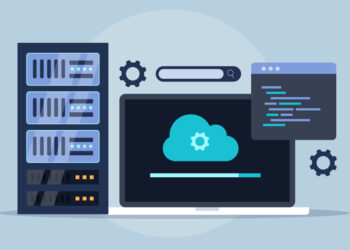In the fiercely competitive realm of enterprise technology, Oracle stands as a formidable and often underestimated powerhouse. While widely renowned for its databases, Oracle’s strategic vision has increasingly centered on its integrated hardware and software solutions, particularly its push into the cloud server market. The narrative of an Oracle Server Cloud Push isn’t just about offering cloud services; it represents a deliberate and aggressive strategy to differentiate itself by providing highly optimized, high-performance, and secure infrastructure designed to run Oracle’s own enterprise applications and databases with unparalleled efficiency. This targeted approach has positioned Oracle Cloud Infrastructure (OCI) as a compelling alternative, especially for large enterprises with complex, mission-critical workloads.
The Evolving Cloud Landscape

The cloud computing market has long been dominated by a few hyperscale providers. However, as enterprises mature in their cloud adoption, they encounter new challenges: the need for specialized performance for demanding applications, stringent security and compliance requirements, and the desire for greater cost predictability for sustained workloads. This evolution in customer demand has created a strategic opening for Oracle. Instead of merely offering generic cloud infrastructure, Oracle has leveraged its deep expertise in enterprise software and databases to build a cloud platform specifically engineered to excel at these challenging workloads.
The Oracle Server Cloud Push is fundamentally about delivering “second-generation” cloud infrastructure that addresses the shortcomings and complexities experienced by enterprises on earlier cloud platforms. It’s about providing robust, secure, and performant servers and services that simplify the migration and operation of enterprise applications, particularly those reliant on Oracle’s extensive software ecosystem. This isn’t just a push; it’s a strategic maneuver to carve out a significant share of the cloud market by targeting high-value, high-performance computing needs.
Pillars of Oracle’s Cloud Server Strategy
Oracle’s aggressive entry and differentiation in the cloud server market are built upon several strategic pillars, each designed to attract and retain enterprise customers.
A. Dedicated and Isolated Infrastructure
One of OCI’s key differentiators is its focus on providing a highly isolated and performant environment, reducing the “noisy neighbor” problem common in multi-tenant cloud architectures.
- Bare Metal Instances: OCI offers true bare metal compute instances, providing customers with direct access to the underlying physical server hardware without a hypervisor layer (or with a thin, non-contending hypervisor). This eliminates virtualization overhead, ensuring maximum performance and predictability for demanding applications like Oracle databases, HPC, and large-scale enterprise applications.
- Isolated Network Virtualization: OCI’s network virtualization is offloaded from the customer’s bare metal or virtual machine instances onto separate network hardware. This “off-box” virtualization ensures that network performance is highly consistent and not impacted by other tenants on the same physical host, enhancing security and predictability.
- Non-Blocking Network Fabric: OCI boasts a flat, non-blocking network fabric designed for extremely low latency and high throughput. This is critical for distributed databases, clustered applications, and HPC workloads that require massive inter-server communication.
- Advantages: Unparalleled performance, enhanced security through strong isolation, predictable latency, and greater control over the underlying infrastructure for specific regulatory compliance needs.
B. Database as a Service (DBaaS) Excellence
Oracle’s heritage is deeply rooted in databases, and its cloud push leverages this strength to offer best-in-class database services.
- Autonomous Database: This is a cornerstone of Oracle’s cloud strategy. The Oracle Autonomous Database is a self-driving, self-securing, and self-repairing database service. It automates critical database management tasks like patching, tuning, security updates, and backups, drastically reducing human error and operational overhead. It automatically scales compute and storage resources up or down based on demand, ensuring optimal performance and cost efficiency.
- Exadata Cloud Infrastructure: Oracle offers its powerful Exadata engineered systems as a service in the cloud. Exadata combines high-performance servers, intelligent storage, and a specialized InfiniBand network to accelerate Oracle database workloads. Providing this in the cloud allows customers to migrate their most demanding on-premises Exadata workloads to OCI with minimal changes, leveraging extreme performance and scalability.
- Flexible Deployment Options: Beyond Autonomous Database and Exadata Cloud, OCI offers a wide range of database services, including Oracle Database Cloud Service (for full control), MySQL HeatWave (for transactional and analytics workloads), and open-source database options. This flexibility allows customers to choose the right database service for their specific needs.
- Seamless Migration: Oracle provides a suite of tools and services to simplify the migration of existing on-premises Oracle databases to OCI, whether to Autonomous Database, Exadata Cloud, or standard cloud instances, reducing the complexity and risk of cloud adoption.
C. Enterprise Workload Optimization
OCI is explicitly designed to handle the complex, resource-intensive workloads that large enterprises often run.
- E-Business Suite and JD Edwards: OCI provides optimized environments and migration paths for running Oracle’s own enterprise applications (like E-Business Suite, JD Edwards, PeopleSoft, Siebel) in the cloud. This offers a compelling value proposition for existing Oracle customers.
- SAP Workloads: OCI is certified to run SAP applications, including SAP HANA, with high performance and reliability. Its bare metal instances and high-performance network fabric are well-suited for demanding SAP environments.
- High-Performance Computing (HPC): With its bare metal compute, high-bandwidth networking, and support for GPUs, OCI is a strong contender for HPC workloads. It enables scientific simulations, computational fluid dynamics, and other compute-intensive tasks at scale.
- AI and Machine Learning: OCI provides powerful GPU-enabled instances (including NVIDIA A100 GPUs) and specialized AI services, making it suitable for training large AI models and deploying machine learning inference at scale.
- Cost Predictability for Enterprise Workloads: For consistent, high-volume enterprise workloads, OCI’s pricing model is often more predictable and potentially more cost-effective than some other hyperscale clouds, especially for sustained usage.
D. Security-First Cloud Architecture
Security is a paramount concern for enterprises, and Oracle has baked security into the core design of OCI.
- Security Zones: Oracle Cloud Infrastructure includes “Security Zones,” which enforce strong security policies from the outset, preventing misconfigurations and ensuring compliance for sensitive workloads.
- Default Security-First Posture: OCI services are designed with security in mind, often enabling security features by default, unlike some other clouds where security configurations might require manual enablement.
- Isolated Network and Compute: As mentioned, the isolated bare metal and off-box network virtualization significantly enhance security by reducing the attack surface and lateral movement risks within a multi-tenant environment.
- Built-in Security Services: OCI provides a comprehensive suite of security services, including Identity and Access Management (IAM), Cloud Guard (for security posture management), Vault (for key management), Web Application Firewall (WAF), DDoS protection, and a Security Information and Event Management (SIEM) service.
- Compliance Certifications: OCI adheres to a broad range of global, regional, and industry-specific compliance standards (e.g., ISO 27001, SOC 1/2/3, PCI DSS, HIPAA, GDPR), making it suitable for regulated industries.
E. Hybrid Cloud and Multi-Cloud Strategy
Oracle understands that enterprises rarely operate in a single cloud. Its strategy embraces hybrid and multi-cloud realities.
- Oracle Cloud@Customer: This offering brings OCI services (including hardware, software, and management) directly into a customer’s data center. It provides the full OCI experience on-premises, ideal for workloads with data residency requirements, low-latency needs, or stringent compliance. It offers cloud agility with on-premises control.
- Dedicated Region Cloud@Customer: For very large enterprises, Oracle can deploy an entire, self-contained OCI region within a customer’s data center, providing all OCI services behind their firewall.
- Oracle Interconnect for Azure: A direct, low-latency interconnection between OCI and Microsoft Azure data centers allows for seamless deployment of multi-cloud architectures, where customers can leverage the best of both clouds (e.g., Azure for frontend/applications, OCI for Oracle databases).
- Open Source and APIs: OCI supports popular open-source technologies (e.g., Kubernetes, Terraform) and provides robust APIs, allowing for easier integration with existing IT environments and other cloud platforms.
Oracle’s Strategic Market Approach
Beyond the technical features, Oracle’s market strategy is integral to its cloud server push.
F. Aggressive Pricing and Cost Predictability
Oracle has adopted an aggressive pricing strategy to attract enterprise customers, particularly those with substantial, predictable workloads.
- Consistent Pricing: OCI often offers consistent pricing across all regions, simplifying cost calculations.
- Low Egress Fees: Compared to some hyperscale providers, OCI’s data egress fees (costs for data leaving the cloud) are often significantly lower or even free for certain tiers, which can be a major cost saver for data-intensive applications.
- Universal Credits: Oracle’s Universal Credits program provides flexible consumption, allowing customers to use any OCI or PaaS service at any time under a single contract, simplifying procurement and enabling greater agility.
- Bring Your Own License (BYOL): Oracle allows customers to bring their existing on-premises software licenses (e.g., Oracle Database licenses) to OCI, significantly reducing cloud migration costs for long-term users.
G. Focus on Enterprise and Mission-Critical Workloads
Unlike some cloud providers that initially focused on startups and web-scale applications, Oracle’s cloud push is explicitly targeting large enterprises with complex, mission-critical applications that demand high performance, reliability, and security. This leverages Oracle’s decades of experience serving this market segment.
H. Customer Relationship and Support
Leveraging its strong existing relationships with enterprise customers, Oracle provides direct, high-touch support and professional services to assist with cloud migrations, optimization, and ongoing management. This hands-on approach differentiates it from more self-service oriented cloud providers.
I. Integrated Hardware and Software Stack
Oracle’s unique advantage stems from its full-stack integration: from silicon (through its SPARC and ARM investments, though primarily using Intel/AMD for OCI compute) to servers, operating systems, databases, and applications. This allows for deep optimization and performance tuning across the entire stack, which is difficult for other cloud providers to replicate.
Challenges and Future Directions

Despite its strategic advantages, Oracle’s cloud server push faces significant challenges in a highly competitive market.
J. Market Share and Brand Perception
- Hyperscale Dominance: Amazon Web Services (AWS), Microsoft Azure, and Google Cloud Platform (GCP) hold dominant market shares and benefit from strong brand recognition and extensive developer ecosystems. Oracle faces an uphill battle to capture significant general-purpose cloud market share.
- “Database Company” Perception: While changing, Oracle is still primarily perceived as a database company, not a general-purpose cloud provider. Overcoming this perception requires sustained marketing and proven customer success stories beyond database migrations.
K. Ecosystem and Services Breadth
- PaaS and SaaS Breadth: While OCI is strong in IaaS and DBaaS, its platform-as-a-service (PaaS) and software-as-a-service (SaaS) offerings might not be as extensive or mature in all areas compared to other hyperscalers.
- Developer Ecosystem: While growing, OCI’s developer community and third-party integrations may not be as broad as those of AWS, Azure, or GCP, which can impact developer adoption.
L. Talent and Skills Availability
- Cloud Skills Gap: The overall cloud skills gap affects all providers. Specifically, expertise in OCI may be less prevalent than for other hyperscalers, potentially impacting customer adoption and talent acquisition.
- Traditional Oracle Skills: While Oracle’s traditional database and application skills are relevant, the shift to cloud operations requires new competencies in cloud architecture, DevOps, and cloud-native development.
M. Regional Availability and Global Footprint
While expanding rapidly, OCI’s global footprint might not yet match the pervasive presence of AWS or Azure in every geography, which can be a factor for global enterprises with specific data residency needs.
N. Cost Management Complexity
While aggressive for enterprise workloads, OCI’s pricing for very small, intermittent, or less predictable workloads (e.g., serverless functions) might not always be the most competitive compared to other hyperscalers, where their pay-per-use models are highly optimized for micro-scale consumption.
Conclusion
The Oracle Server Cloud Push is a bold and calculated move that leverages Oracle’s core strengths to carve out a distinct and valuable position in the cloud market. By focusing on dedicated and isolated infrastructure, delivering unrivaled Database-as-a-Service excellence (especially with Autonomous Database and Exadata), optimizing for mission-critical enterprise workloads, and designing with security at its core, Oracle Cloud Infrastructure offers a compelling value proposition for a specific, high-value segment of the market.
Its embrace of hybrid and multi-cloud strategies through Cloud@Customer and direct interconnects further demonstrates its pragmatic approach to enterprise realities. While facing stiff competition and the challenge of perception, Oracle’s continuous investment in performance, security, and unique full-stack optimization positions it as a formidable force. For large enterprises seeking a reliable, high-performance, and secure cloud environment tailored for their most demanding applications and databases, Oracle Cloud Infrastructure is no longer just an option; it’s an increasingly powerful and strategically relevant choice that continues to push the boundaries of what cloud servers can achieve.










